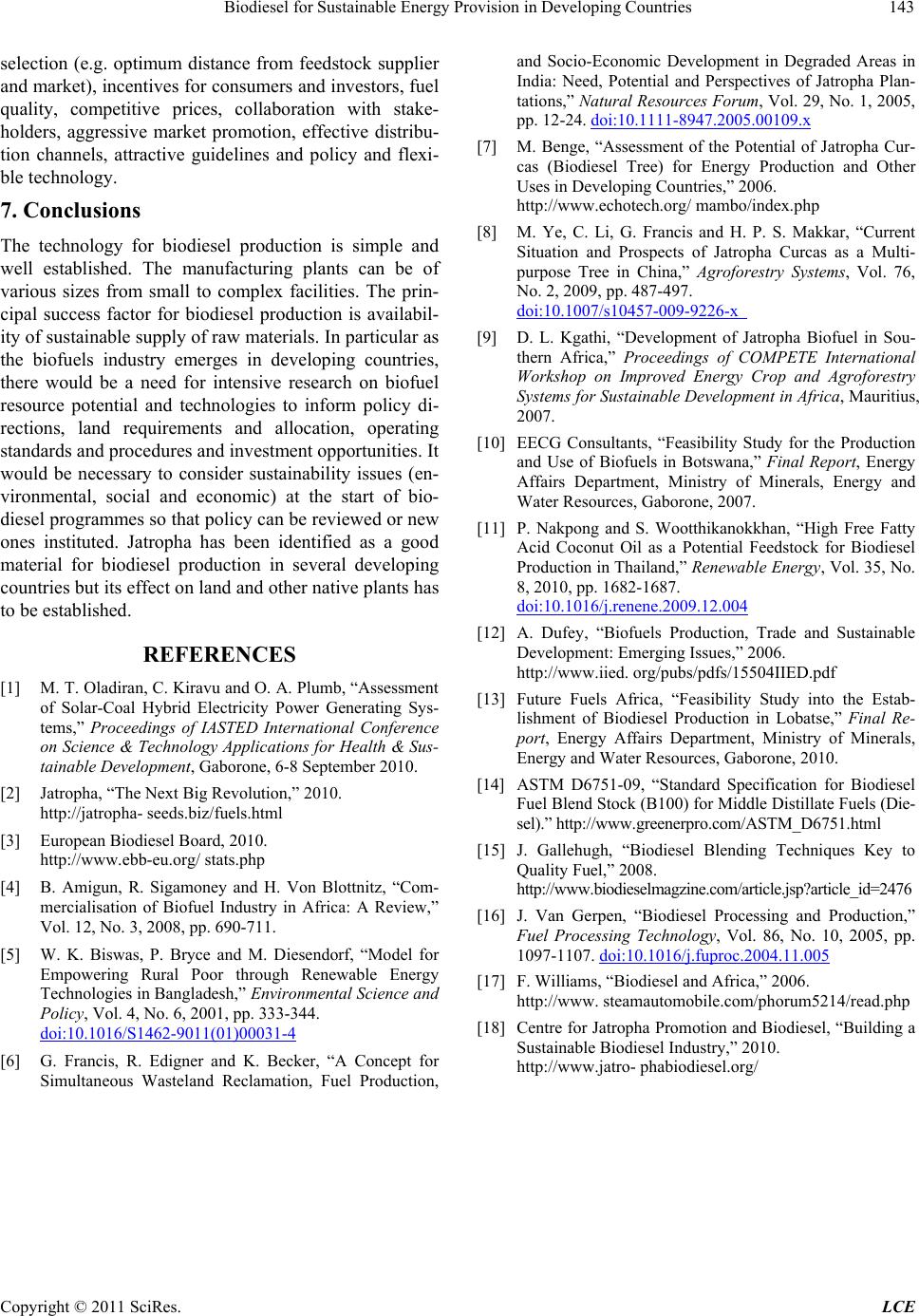
Biodiesel for Sustainable Energy Provision in Developing Countries
Copyright © 2011 SciRes. LCE
143
selection (e.g. optimum distance from feedstock supplier
and market), incentives for consumers and investors, fuel
quality, competitive prices, collaboration with stake-
holders, aggressive market promotion, effective distribu-
tion channels, attractive guidelines and policy and flexi-
ble technology.
7. Conclusions
The technology for biodiesel production is simple and
well established. The manufacturing plants can be of
various sizes from small to complex facilities. The prin-
cipal success factor for biodiesel production is availabil-
ity of sustainable supply of raw materials. In particular as
the biofuels industry emerges in developing countries,
there would be a need for intensive research on biofuel
resource potential and technologies to inform policy di-
rections, land requirements and allocation, operating
standards and procedures and investment opportunities. It
would be necessary to consider sustainability issues (en-
vironmental, social and economic) at the start of bio-
diesel programmes so that policy can be reviewed or new
ones instituted. Jatropha has been identified as a good
material for biodiesel production in several developing
countries but its effect on land and other native plants has
to be established.
REFERENCES
[1] M. T. Oladiran, C. Kiravu and O. A. Plumb, “Assessment
of Solar-Coal Hybrid Electricity Power Generating Sys-
tems,” Proceedings of IASTED International Conference
on Science & Technology Applications for Health & Sus-
tainable Development, Gaborone, 6-8 September 2010.
[2] Jatropha, “The Next Big Revolution,” 2010.
http://jatropha- seeds.biz/fuels.html
[3] European Biodiesel Board, 2010.
http://www.ebb-eu.org/ stats.php
[4] B. Amigun, R. Sigamoney and H. Von Blottnitz, “Com-
mercialisation of Biofuel Industry in Africa: A Review,”
Vol. 12, No. 3, 2008, pp. 690-711.
[5] W. K. Biswas, P. Bryce and M. Diesendorf, “Model for
Empowering Rural Poor through Renewable Energy
Technologies in Bangladesh,” Environmental Science and
Policy, Vol. 4, No. 6, 2001, pp. 333-344.
doi:10.1016/S1462-9011(01)00031-4
[6] G. Francis, R. Edigner and K. Becker, “A Concept for
Simultaneous Wasteland Reclamation, Fuel Production,
and Socio-Economic Development in Degraded Areas in
India: Need, Potential and Perspectives of Jatropha Plan-
tations,” Natural Resourc es Forum, Vol. 29, No. 1, 2005,
pp. 12-24. doi:10.1111-8947.2005.00109.x
[7] M. Benge, “Assessment of the Potential of Jatropha Cur-
cas (Biodiesel Tree) for Energy Production and Other
Uses in Developing Countries,” 2006.
http://www.echotech.org/ mambo/index.php
[8] M. Ye, C. Li, G. Francis and H. P. S. Makkar, “Current
Situation and Prospects of Jatropha Curcas as a Multi-
purpose Tree in China,” Agroforestry Systems, Vol. 76,
No. 2, 2009, pp. 487-497.
doi:10.1007/s10457-009-9226-x
[9] D. L. Kgathi, “Development of Jatropha Biofuel in Sou-
thern Africa,” Proceedings of COMPETE International
Workshop on Improved Energy Crop and Agroforestry
Systems for Sustainable Development in Africa, Mauritius,
2007.
[10] EECG Consultants, “Feasibility Study for the Production
and Use of Biofuels in Botswana,” Final Report, Energy
Affairs Department, Ministry of Minerals, Energy and
Water Resources, Gaborone, 2007.
[11] P. Nakpong and S. Wootthikanokkhan, “High Free Fatty
Acid Coconut Oil as a Potential Feedstock for Biodiesel
Production in Thailand,” Renewable Energy, Vol. 35, No.
8, 2010, pp. 1682-1687.
doi:10.1016/j.renene.2009.12.004
[12] A. Dufey, “Biofuels Production, Trade and Sustainable
Development: Emerging Issues,” 2006.
http://www.iied. org/pubs/pdfs/15504IIED.pdf
[13] Future Fuels Africa, “Feasibility Study into the Estab-
lishment of Biodiesel Production in Lobatse,” Final Re-
port, Energy Affairs Department, Ministry of Minerals,
Energy and Water Resources, Gaborone, 2010.
[14] ASTM D6751-09, “Standard Specification for Biodiesel
Fuel Blend Stock (B100) for Middle Distillate Fuels (Die-
sel).” http://www.greenerpro.com/ASTM_D6751.html
[15] J. Gallehugh, “Biodiesel Blending Techniques Key to
Quality Fuel,” 2008.
http://www.biodieselmagzine.com/article.jsp?article_id=2476
[16] J. Van Gerpen, “Biodiesel Processing and Production,”
Fuel Processing Technology, Vol. 86, No. 10, 2005, pp.
1097-1107. doi:10.1016/j.fuproc.2004.11.005
[17] F. Williams, “Biodiesel and Africa,” 2006.
http://www. steamautomobile.com/phorum5214/read.php
[18] Centre for Jatropha Promotion and Biodiesel, “Building a
Sustainable Biodiesel Industry,” 2010.
http://www.jatro- phabiodiesel.org/